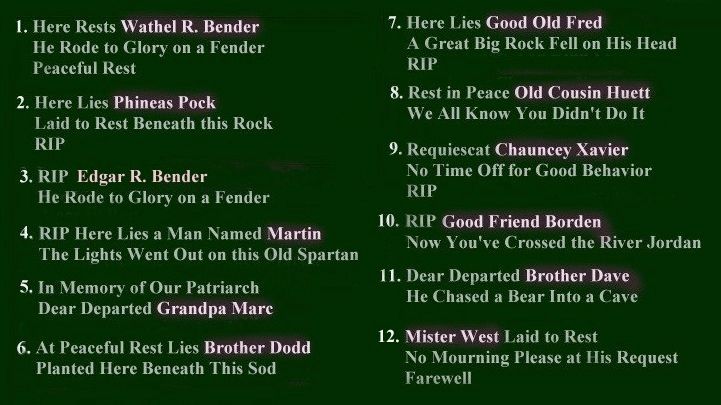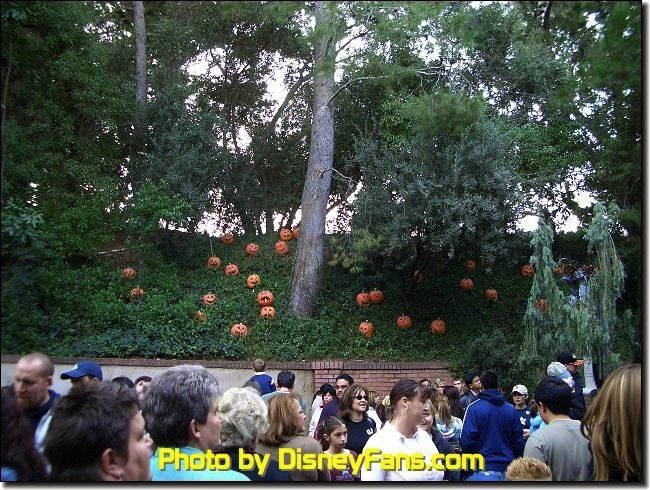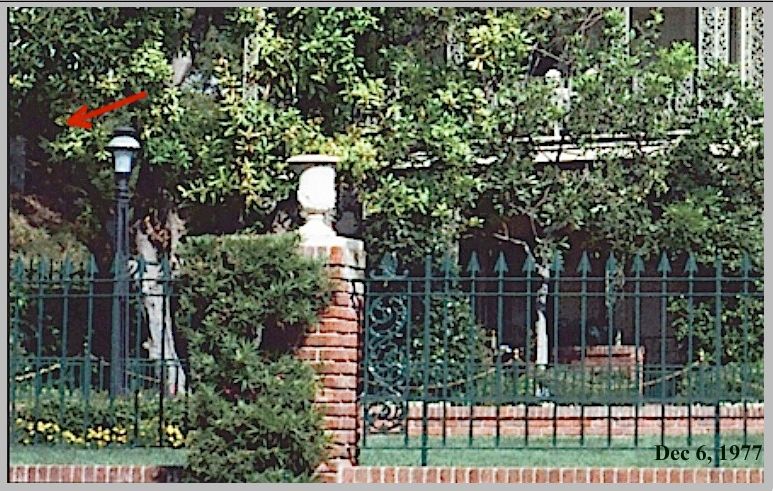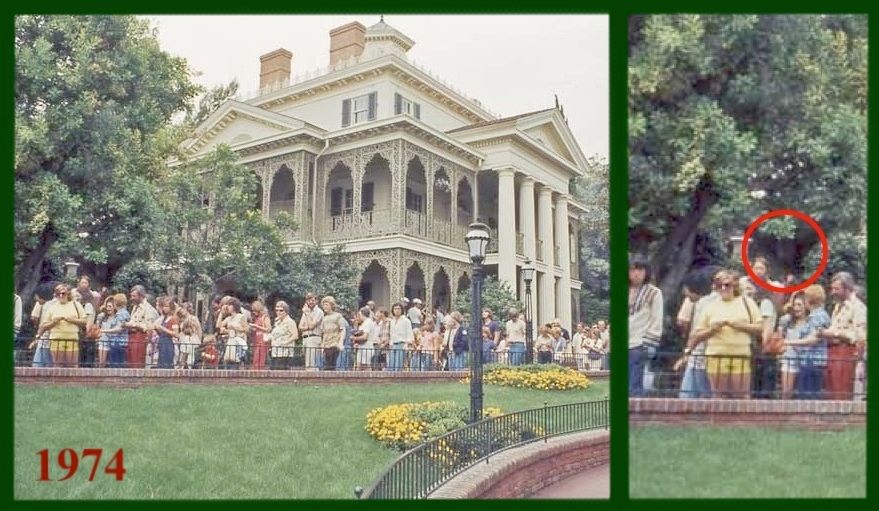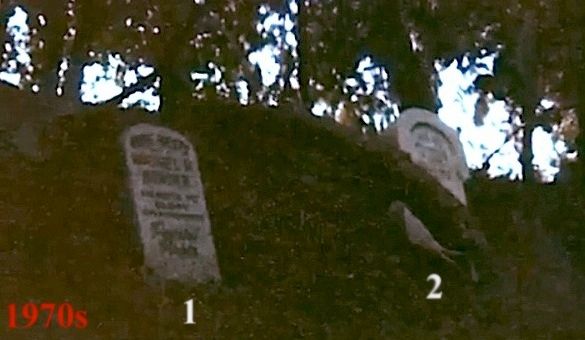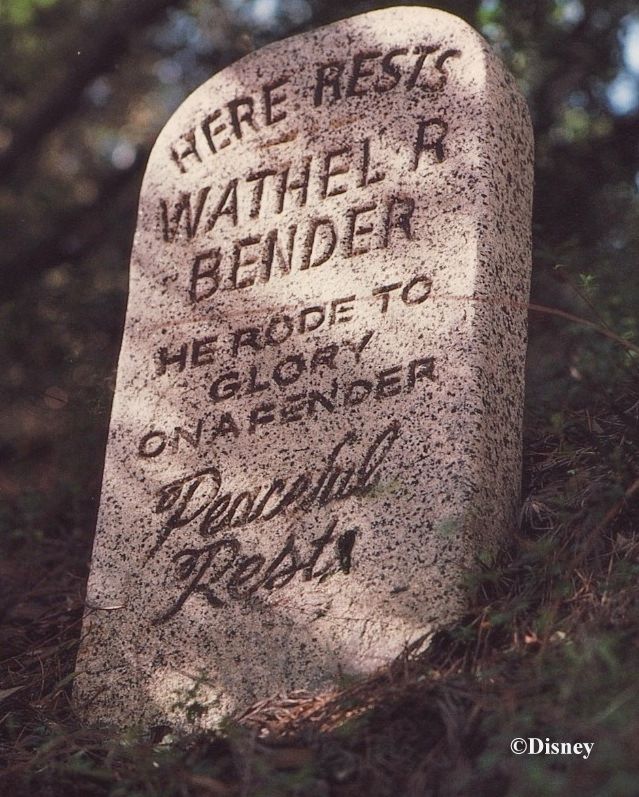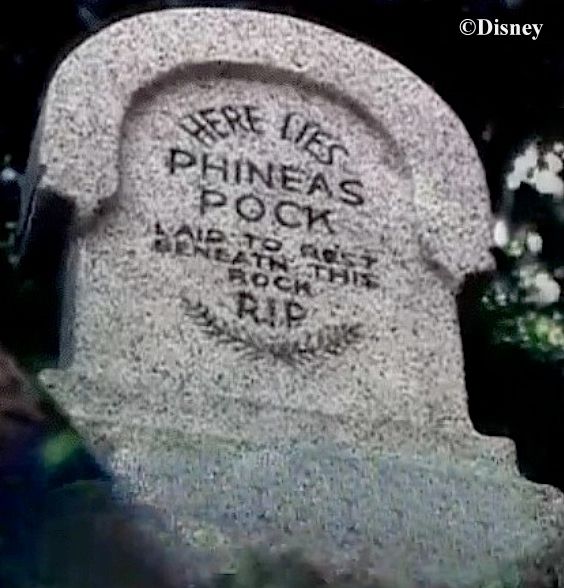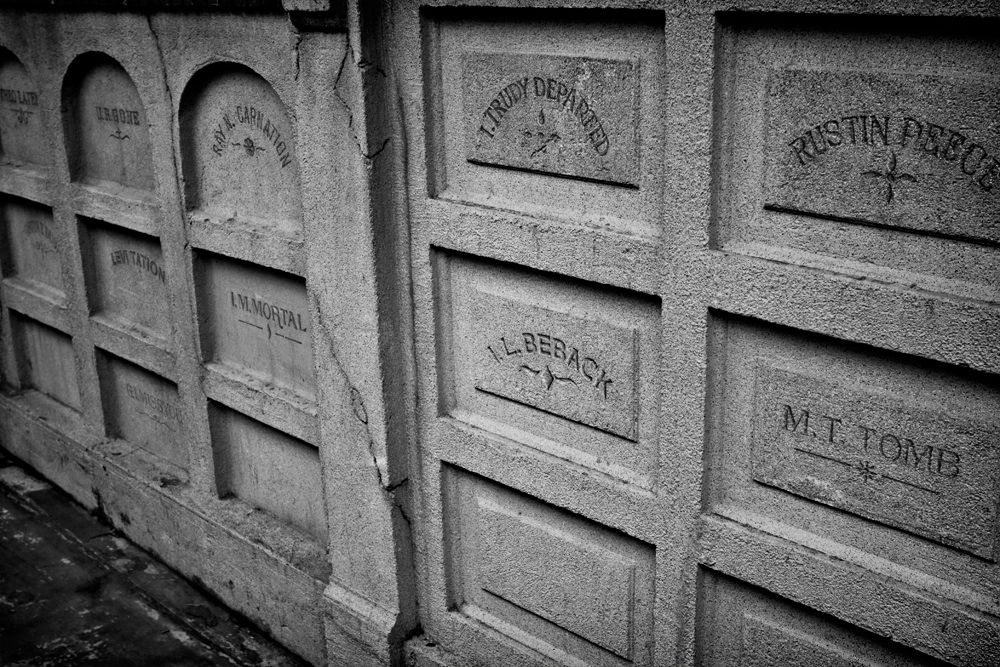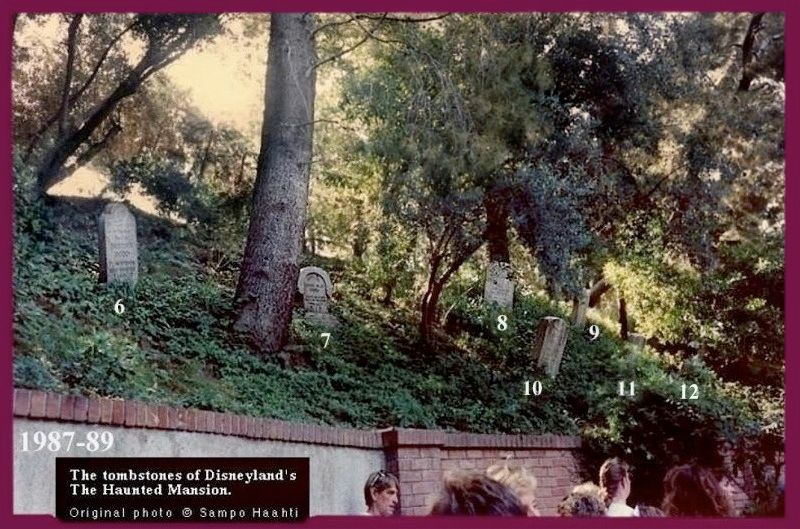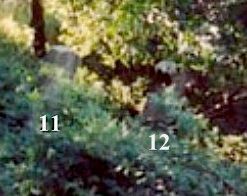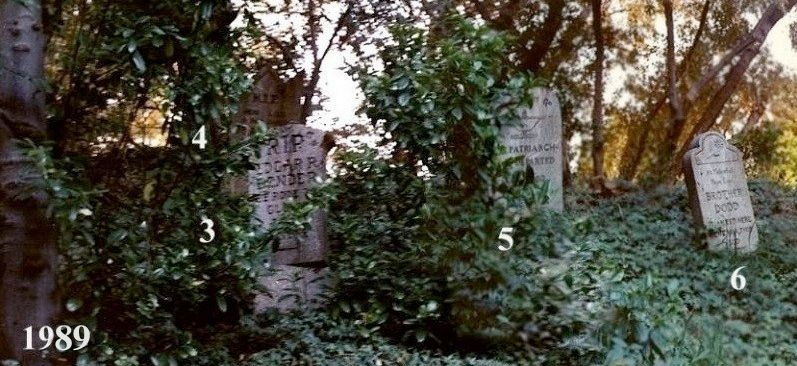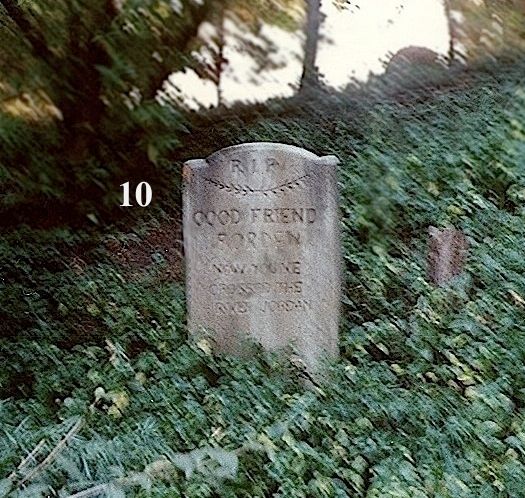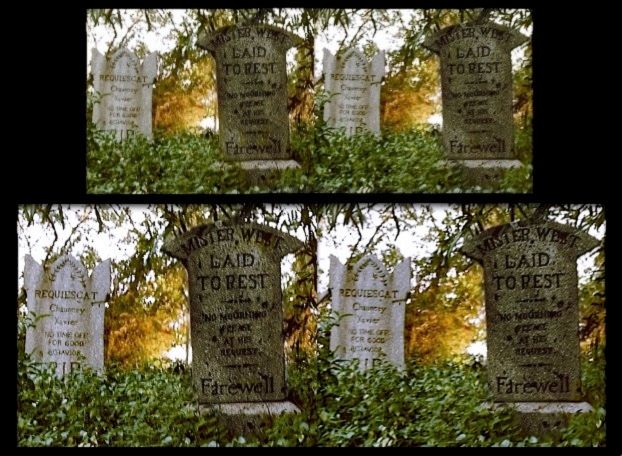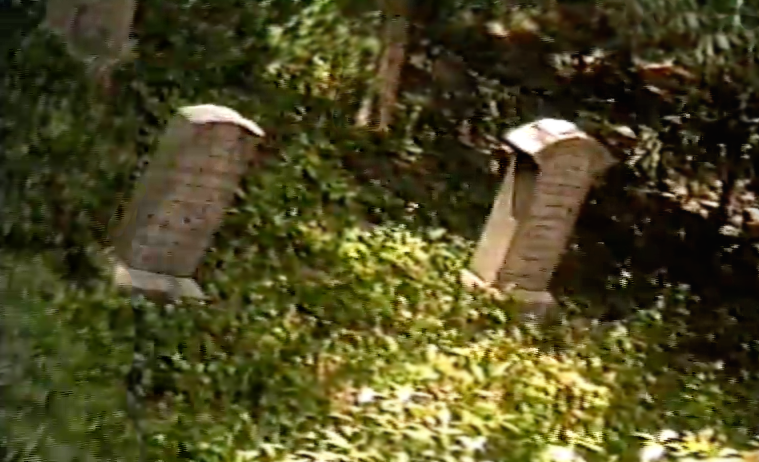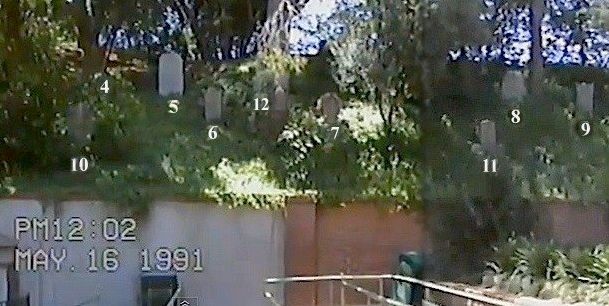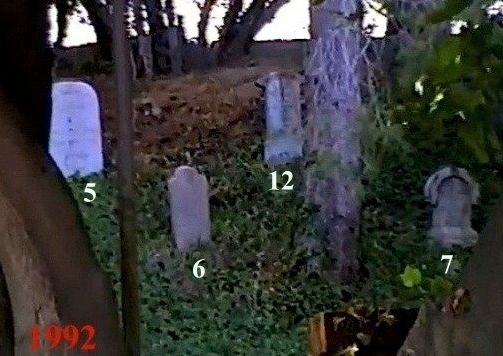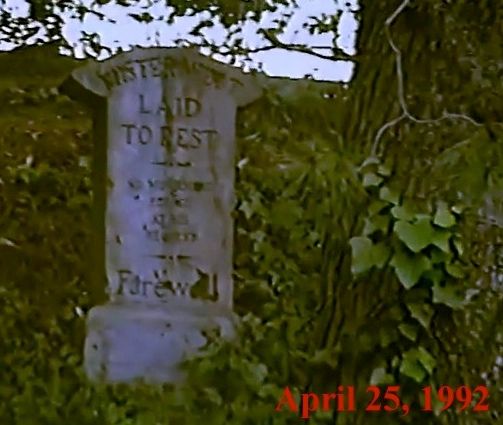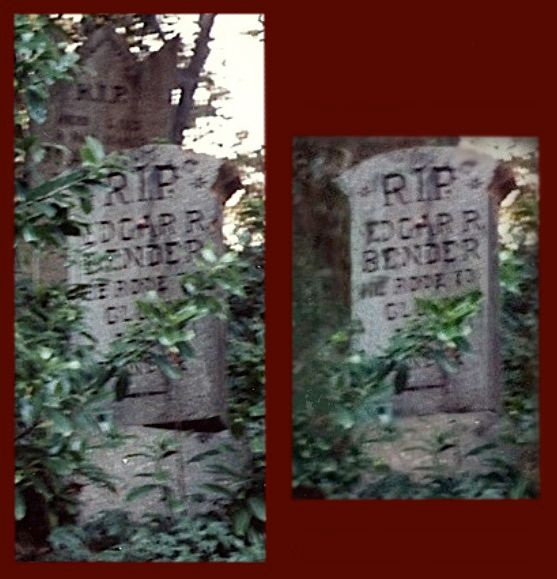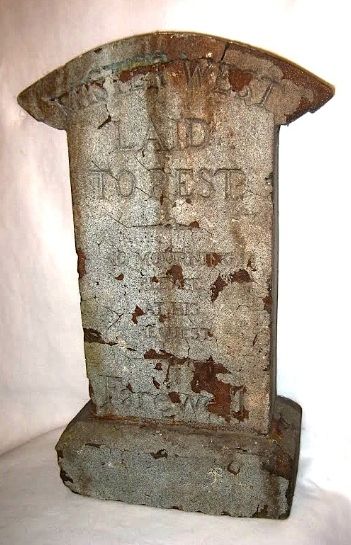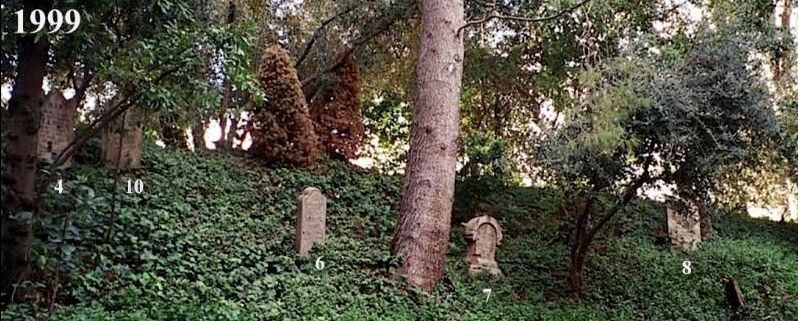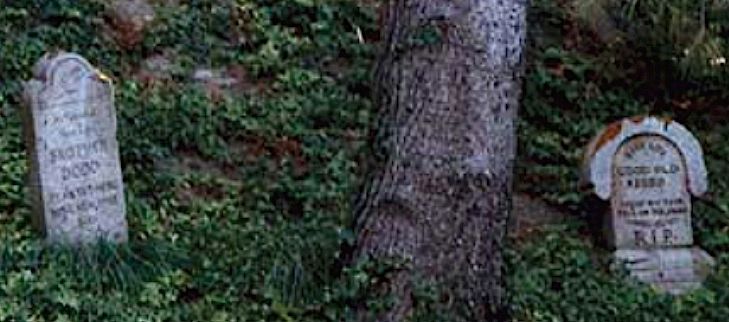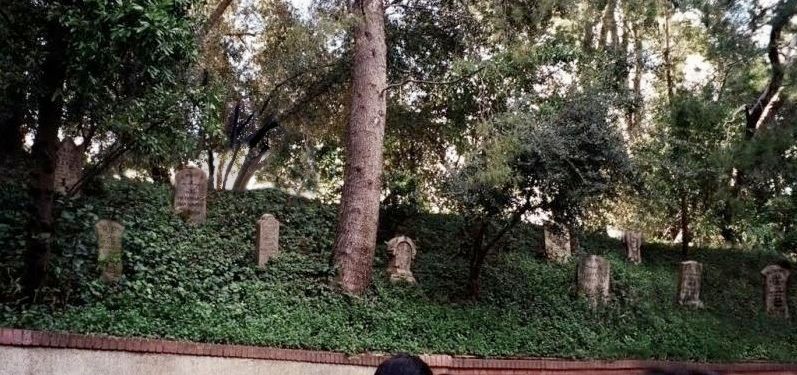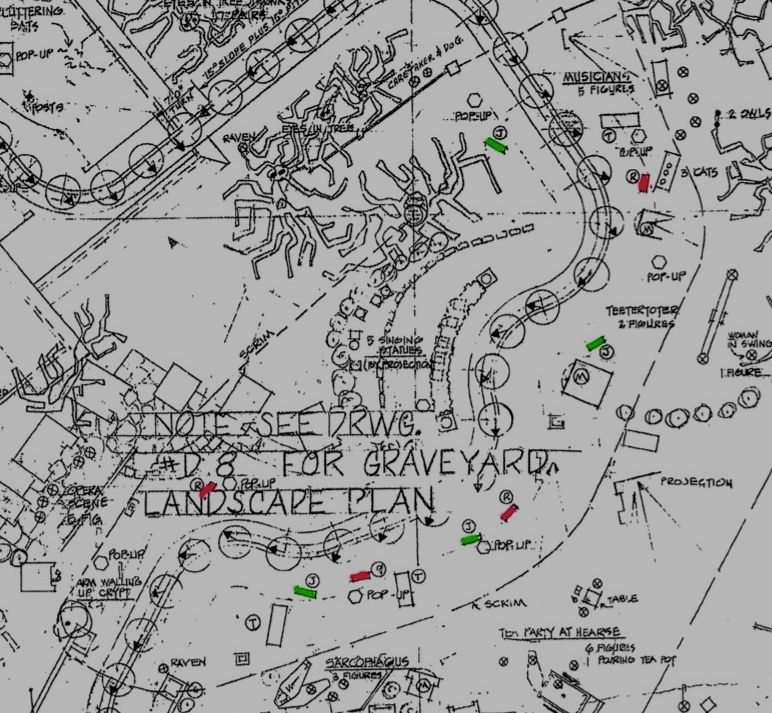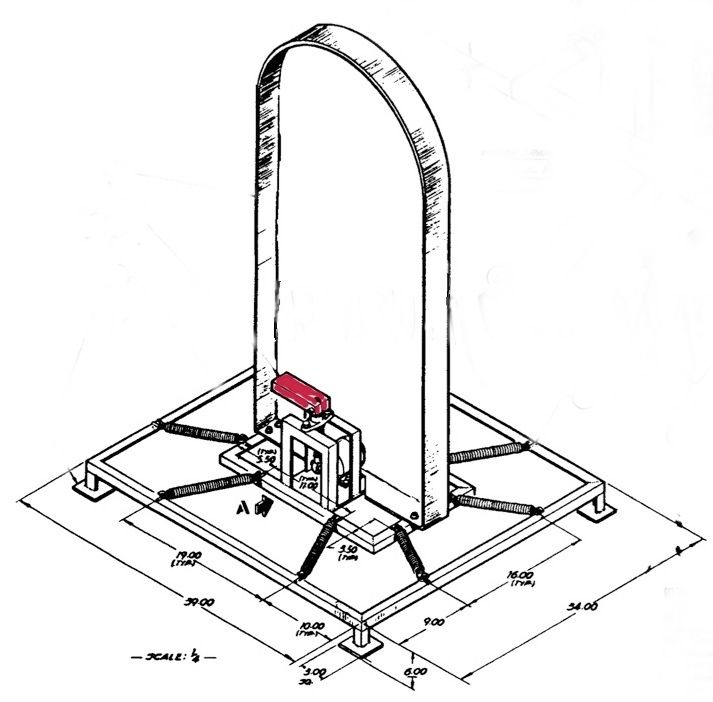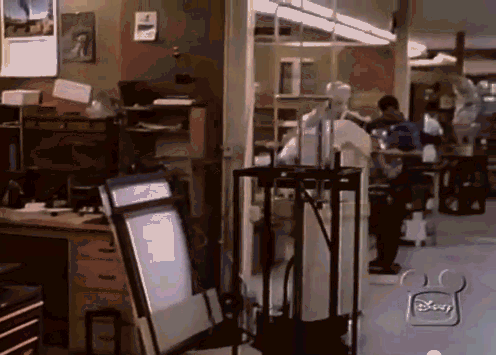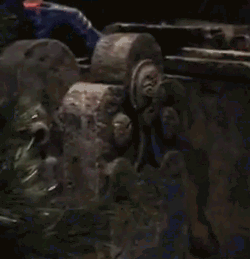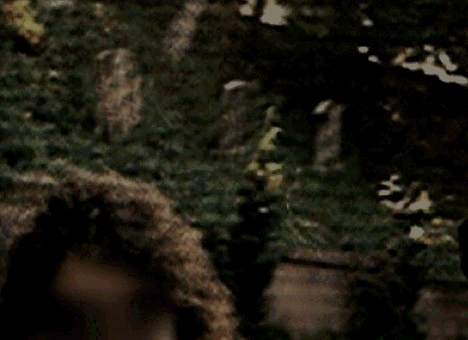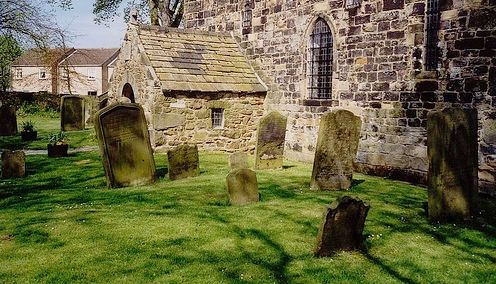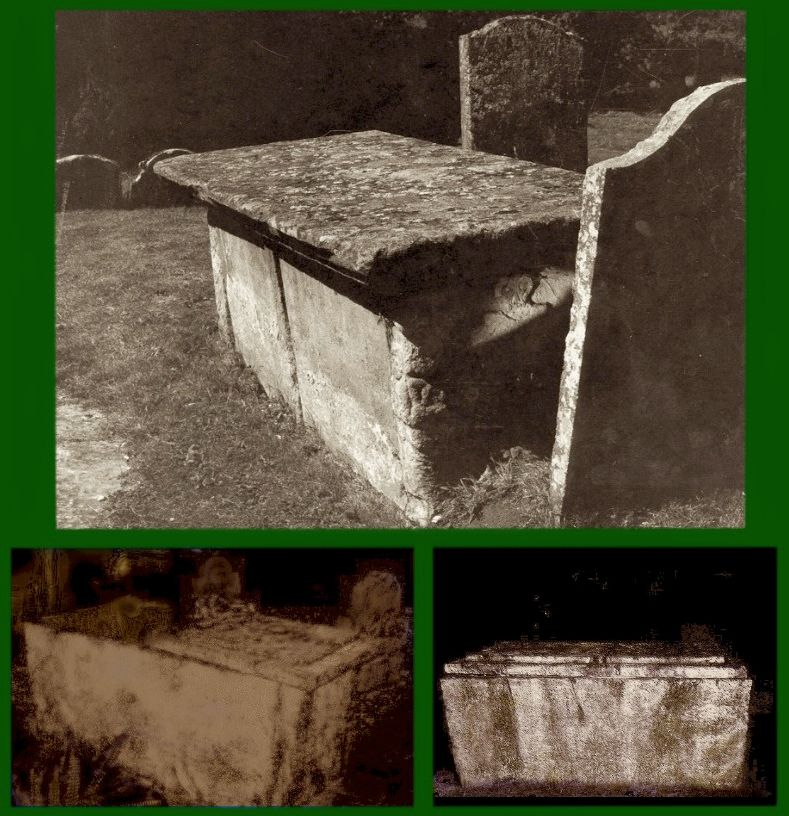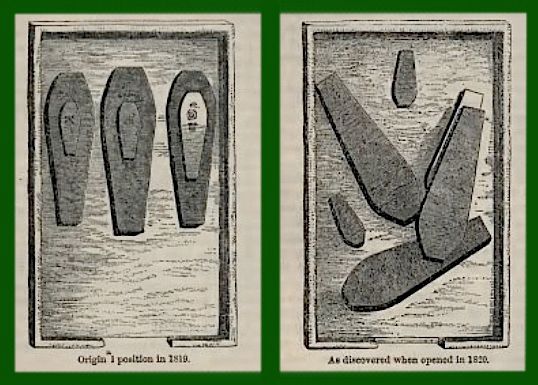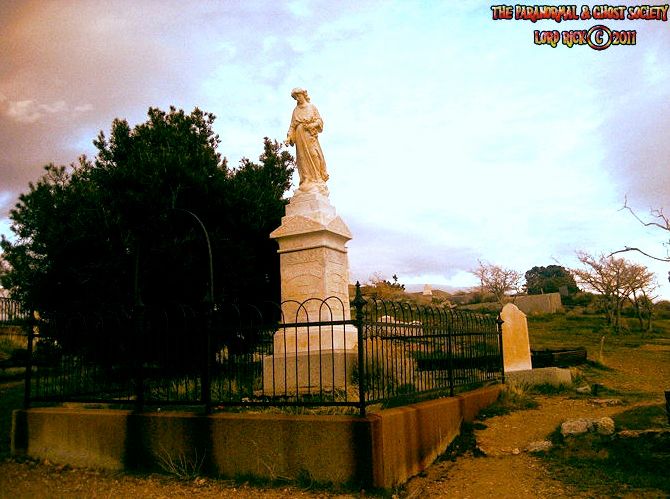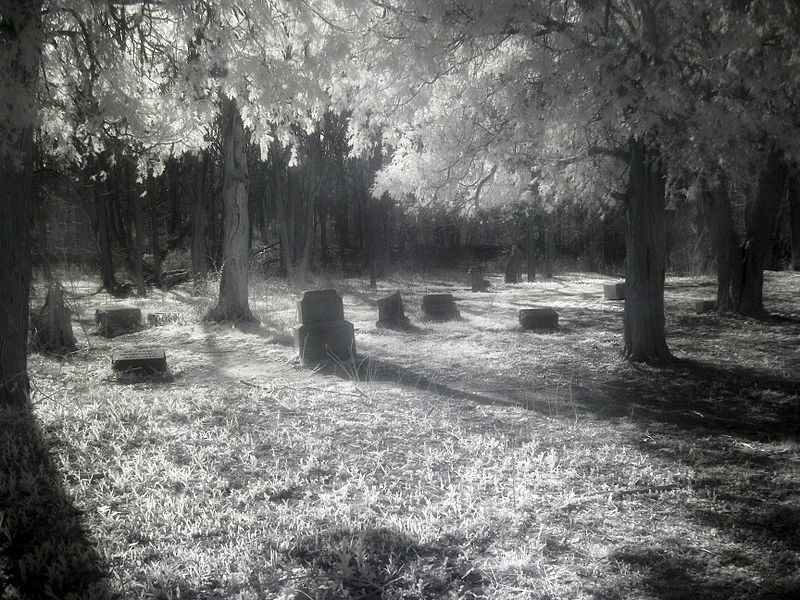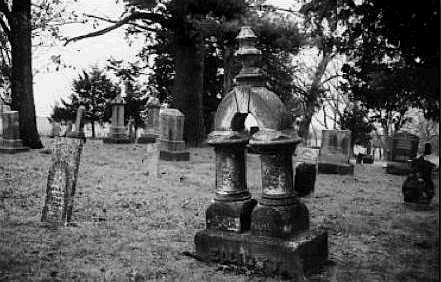.
The first part of this post is a sequel to a 2010 post, That's My Queue, and if you haven't read that one, I suggest you read it first. That earlier post deals with the original "family plot" at Disneyland that lasted less than nine months before being replaced with additional queueing. The Imagineers tried to make up for the loss by putting a new cemetery up on the berm. That one lasted until 2000, then . . . poof.
If this sort of thing smacks of trivia for trivia's sake to some of you, let me smack back: (1) there are a lot of Mansion fans who would love to see the berm graveyard return, so it's still a live topic, and (2) this thing should be documented while it's still possible to do so, before the memories fade any further. The berm graveyard has been gone now for fourteen years. If not now, when? If not here, where? Besides, there are whimsical twists at the end that will send us out in search of artistic influences, a Long-Forgotten staple, so fear not, oh ye right-brain-dominated readers.
The original family plot was removed in May of 1970, but precisely when the berm cemetery debuted I don't know. It actually came in two stages, the first one brief and miniscule, the second one big and long-lasting. That second stage is the one people are thinking about when they speak of the "berm graveyard." This photo proves that it was there by December of 1977 at the latest:
The earliest photo I've seen that shows tombstones on the berm, however, is probably the one below, which you'll recognize from the earlier
post. That's #1 ("Wathel R. Bender") and #2 ("Phineas Pock") somewhere near the top of the ridge, sometime between 1972 and 1977.
(How do I know? The snapshot is from a batch of DL photos taken after Country Bears but before Big Thunder Mountain RR.)
So, if our analysis is correct, the berm graveyard that we all mean when we say "berm graveyard" made its debut in 1973, give or take one year.
Right now that's the best I can do with the 1970s, and it's not a lot of solid info, is it? That's okay; wave bye-bye and say a rubber ducky to Wathel R. Bender and Phineas Pock, because they play no part in the rest of our story.
The 1980s
Long-Forgotten
The disappearance of "Edgar R. Bender" (#3) ensured that this headstone would sink into obscurity more quickly and deeply than the others. Carter's 1989 snapshot of "Edgar" is the only one I have ever seen, and even in that photo it looks like it's in trouble. It appears to have swiveled awkwardly out of position on its base. That might explain why it was removed rather than repositioned in 1990-91, but who knows? If any of you remember it, you're doing better than I am, because frankly, without Carter's photo, I wouldn't have known that this tombstone ever existed.
Reconstruction (right) based on Carter photo (left)
FACT:
The first part of this post is a sequel to a 2010 post, That's My Queue, and if you haven't read that one, I suggest you read it first. That earlier post deals with the original "family plot" at Disneyland that lasted less than nine months before being replaced with additional queueing. The Imagineers tried to make up for the loss by putting a new cemetery up on the berm. That one lasted until 2000, then . . . poof.
proof of the poof
When I wrote the earlier post I didn't have very much information about the berm graveyard,
and I still can't give you anything like a complete history, but I've accumulated enough data to
at least put together something resembling a coherent narrative, even if it has some holes in it.
at least put together something resembling a coherent narrative, even if it has some holes in it.
Eric (MrDisneyfanman)
If this sort of thing smacks of trivia for trivia's sake to some of you, let me smack back: (1) there are a lot of Mansion fans who would love to see the berm graveyard return, so it's still a live topic, and (2) this thing should be documented while it's still possible to do so, before the memories fade any further. The berm graveyard has been gone now for fourteen years. If not now, when? If not here, where? Besides, there are whimsical twists at the end that will send us out in search of artistic influences, a Long-Forgotten staple, so fear not, oh ye right-brain-dominated readers.
But the left-brained discussion comes first. We begin with a montage of the twelve known berm tombstones, numbered for easy reference.
#1 and #2 were actual transplants from the original family plot. #5 had the same epitaph as one of the originals, .
but the stone itself was new and redesigned.
but the stone itself was new and redesigned.
#3, #6, #9, and #12 were redesigned versions of four original DL stones, but with changes in the texts (#3 "Edgar">
"Wathel"; #6 "Dodd"> "Claude"; #9 "Chauncey"> "Francis"; #12 "Mister West"> "Master Gracey").
"Wathel"; #6 "Dodd"> "Claude"; #9 "Chauncey"> "Francis"; #12 "Mister West"> "Master Gracey").
#4, #7, and #11 were NOT part of the original DL plot and debuted on the berm. The epitaphs are the same as .
stones still to be found in the WDW graveyard, but the designs are different.
stones still to be found in the WDW graveyard, but the designs are different.
#8 and #10 were also new to DL and similar to WDW stones, but differently designed and with small variations in .
the texts (#8 "Old Cousin Huett"> "Cousin Huet"; #11 "Borden">"Gordon").
the texts (#8 "Old Cousin Huett"> "Cousin Huet"; #11 "Borden">"Gordon").
Gosh, already I feel so . . . so white-coat-and-clipboard-y.
As you can see, except for the two transplants (#1 and #2), all of the berm stones were reproductions of stones from either the DL or the WDW original cemeteries, but none of them was an exact replica and the names were altered on some of them. It's been suggested that the alterations may have been for the purpose of paying tribute to other Imagineers, but I haven't (yet) come across a "Borden" or "West" or "Dodd" or "Edgar" who worked on the original HM. And why did "Francis Xavier" become "Chauncey Xavier" and "Cousin Huet" become "Old Cousin Huett"? I can't imagine.
for that crime, anyway. Below, we'll discover the true reason for the disappearance.
The 1970spic by Allen Huffmann
During the Haunted Mansion Holiday the hillside is covered in jack o' lanterns, and for this reason there was a time when Jack Skellington was blamed for eliminating the berm graveyard, but we now know that it was removed a full year before the first HMH overlay, so he's off the hookfor that crime, anyway. Below, we'll discover the true reason for the disappearance.
The original family plot was removed in May of 1970, but precisely when the berm cemetery debuted I don't know. It actually came in two stages, the first one brief and miniscule, the second one big and long-lasting. That second stage is the one people are thinking about when they speak of the "berm graveyard." This photo proves that it was there by December of 1977 at the latest:
But judging by this photo, it looks like it was there by 1974. That isn't a tree.
The earliest photo I've seen that shows tombstones on the berm, however, is probably the one below, which you'll recognize from the earlier
post. That's #1 ("Wathel R. Bender") and #2 ("Phineas Pock") somewhere near the top of the ridge, sometime between 1972 and 1977.
(How do I know? The snapshot is from a batch of DL photos taken after Country Bears but before Big Thunder Mountain RR.)
Eric (Mrdisneyfanman)
It may not look like much to you, but it impressed the holy heck out of some photographer.
Incidentally, you may not realize it, but you've been looking at these two in
their original home at the family plot for as long as you've been reading this blog.
their original home at the family plot for as long as you've been reading this blog.
They were apparently the only two re-used in this manner, so I suspect that they were placed on the berm very soon after
the family plot was dismantled, perhaps immediately. Also, this is probably when the names on the crypts first appeared.
the family plot was dismantled, perhaps immediately. Also, this is probably when the names on the crypts first appeared.
pic by Keary Ingrum Jr.
However, there were apparently no plans to include stones #1 and #2 in the new graveyard being designed at that time, so their days on the berm were numbered. They were removed no earlier than 1972 and probably no later than the debut of the new cemetery (i.e. stones #3 — #12), which appears to have taken place sometime between 1972 and 1974. Why do I assume that the two transplants were taken out before that debut? Because it hardly seems possible that #1 and #3 would ever have been on display at the same time, with both Wathel and Edgar surnamed "Bender" and both of them riding to glory on a fender.*
(*I suppose it should be noted that if by some freak chance #3 "Edgar" was not added until later, then it's conceivable that #1 and #2 hung around for awhile in the new graveyard. Since our only photo of Edgar dates from 1989, such a possibility cannot be ruled out entirely, but currently there's no evidence in favor of it, and the simpler working assumption is that the new graveyard went in en masse, not piecemeal. Furthermore, that 1989 photo shows Edgar in need of repair, suggesting that it had been there for awhile.)
(*I suppose it should be noted that if by some freak chance #3 "Edgar" was not added until later, then it's conceivable that #1 and #2 hung around for awhile in the new graveyard. Since our only photo of Edgar dates from 1989, such a possibility cannot be ruled out entirely, but currently there's no evidence in favor of it, and the simpler working assumption is that the new graveyard went in en masse, not piecemeal. Furthermore, that 1989 photo shows Edgar in need of repair, suggesting that it had been there for awhile.)
Right now that's the best I can do with the 1970s, and it's not a lot of solid info, is it? That's okay; wave bye-bye and say a rubber ducky to Wathel R. Bender and Phineas Pock, because they play no part in the rest of our story.
The 1980s
The earliest photo I've seen that includes most of the new graveyard in one shot is this one, probably taken in 1988, give or take one year.
Before you get out your magnifying glass, here's a close-up of the far right.
The far left of the graveyard is out of frame in that one, but a fellow named Gary Carter took a
number of snapshots of the berm in 1989, and by cunningly stitching together a couple of them,
we can see what the left end looked like. Here's a montage of some of his separate photos.
number of snapshots of the berm in 1989, and by cunningly stitching together a couple of them,
we can see what the left end looked like. Here's a montage of some of his separate photos.
Here's the stitch-together:
As for the far right, we are blessed with a splendid shot by Gordon Free, dated about 1986. I've posted it before. It
is most welcome, because it's a little hard to make out the stones down there in the 1987-89 photo, let alone read them.
"Good Friend Borden" (#10) is out of frame on the left, but Carter also took a
couple of shots at this end of the berm, and a blurry Borden is in one of them.
Incidentally, with only a few very minor adjustments Carter's two photos of #9 and #12 can be combined for a nice 3D:
Okay, now we're in pretty good position to draw a layout of the graveyard. These
are only eyeball estimates, so don't rely on them for exact scales or precise locations.
Notice how nicely perpendicular #11 and #12 are in the 1986 Free photo? In the panoramic 1988-ish shot, however, those
front row tombstones are beginning to lean forward. I'm afraid there's trouble a-brewin' for our brave little graveyard.
By 1989, they looked like this:
. The 1990s
. By 1990, the front row was tilting at an alarming pitch.
pic by Effie3
And so, sometime before May of 1991, they reshuffled the graveyard. "Good Friend Borden" (#10) moved to the far left and displaced "Edgar R. Bender" (#3). "Mister West" (#12) was also relocated to the left, to an empty spot farther up the berm. "Brother Dave" (#11) was scooted over to #10's old spot, approximately.
(pics by Andrew Fazzi)
Here's the layout after The Big Shakeup:
There's no guesswork here; the stones can all be identified quite positively. Here are some later shots clearly
showing #10, #11, and #12 in their new locations, once again standing at attention, straight and tall. So inspiring.
gif made from videos by David Myers (1996) and Eric MrDisneyfanman (1994)
(pic by David Wight)
Eric (MrDisneyfanman)
Long-Forgotten
The disappearance of "Edgar R. Bender" (#3) ensured that this headstone would sink into obscurity more quickly and deeply than the others. Carter's 1989 snapshot of "Edgar" is the only one I have ever seen, and even in that photo it looks like it's in trouble. It appears to have swiveled awkwardly out of position on its base. That might explain why it was removed rather than repositioned in 1990-91, but who knows? If any of you remember it, you're doing better than I am, because frankly, without Carter's photo, I wouldn't have known that this tombstone ever existed.
The Beginning of the End
After the shakeup, things remained stable for a year or two, or three at most. But then—what's this? By 1994, "Mister West"
(#12) and "Brother Dave" (#11) have disappeared. Aww. And here we all thought they were so happy in their new homes.
Eric (MrDisneyfanman)
(pic by Jeff Lange. The stone was definitely gone by 1994.)
Why did they vanish? Judging by the fact that #12 later turned up in the collectors market
looking like crap on a stick, one may suppose that they were taken out because they were
deteriorating. (The "stones" were fiberglass and resin skins filled with polystyrene foam.)
So apparently it was a matter of pulling a couple of rotten teeth. The remaining seven stones survived for several years, but eventually it was necessary to perform more hillside dentistry. Au revoir, Grandpa (#5). Adios, Chauncey (#9). Good Friend Borden (#10) was moved for the second time and placed next to Martin (#4). We always knew he crossed the River Jordan, but it looks like he crossed an impressive stretch of dry land as well. Anyway, here we are in 1999, with only five stones left of the original ten in this layout.
(pic by Mina Hart)
In some late 90s photos you can see the same type of deterioration begin-
ning to eat away the remaining stones. The handwriting was on the wall.
Epitaph for a Graveyard
And so, dear friends, you now know why the berm graveyard was removed in 2000: It was falling apart. Time and the elements took
their toll. Aye, but in's prime, wasna it a bonny sight to see? (I'm thinking how good "Amazing Grace" on bagpipes would sound here.)
A recreation of the graveyard at its apogee.
And the Tombstones Quake
Believe it or not, there are a couple of curious ironies (or ironic curiosities) nestled deep within that safe and sane history you have just read. First, it seems that between 1986 and 1990 the natural elements replicated outside in excruciatingly slow motion what the Imagineers did inside as a special effect. Second, between 1991 and 1999 the maintenance folks inadvertently replicated a "real" paranormal phenomenon in their attempts to deal with an utterly normal phenomenon. A happy accident, you might call it. I prefer to think of it as extra value. Anyway, let us take up each of these oddities in turn.
1986 - 1990: Nature Imitates Art
As you know, some of the tombstones in the graveyard scene are animated. There are actually two kinds, "jigglers" and "rumblers," and there are four of each. The others behave themselves and stand still. For you hypergeeks, here is a DL blueprint showing you exactly where they are, with jigglers in green, rumblers in red.
The jiggler variety is ingenious and ridiculously simple, probably another Yale Gracey invention. The tombstone is very lightweight and suspended on a metal frame by means of springs. A motor in the back spins an off-center weight around, and ta da, the tombstone rocks back and forth. I've colored the weight red.
The rumblers are more complex, featuring a mechanized tombstone sticking up through a hole in the floor, rising, sinking, and rocking back and forth. You can see one of these in the 1970 "Disneyland Showtime" TV special, still in the shop and bobbing up and down like a hyperactive five-year-old who really needs to find a restroom soon (notice also the pop-up spook). If Sigmund Freud were here, he'd probably have some things to say about it as well.
That gif is a little fast, but even at normal speed, it's clear that the rumblers were slowed down
for the ride. One can also see some fore-and-aft movement along with the side-to-side rocking.
And now,
through the miracle of fake time-lapse photography, look what transpired
on the berm between 1986 and 1990. Like I said, it's Nature imitating Art!
Restless Bones
I'm not aware of any precise parallel in traditional ghost lore to supernaturally wobbling tombstones, but in England and elsewhere in the
Old World they've got hundreds, if not thousands of old churchyards showing how the markers do indeed move, tilting in different directions.
Plenty of examples can be seen in the older cemeteries of New England as well.
This is, of course, simply what happens over a long period of time as the stones settle, but to someone scouting around for haunted house ideas,
a sight like this might give rise in the imagination to restless spirits below pushing upwards. We're back to Art imitating Nature. Beyond this conjecture, can we find anything specific that may have served more directly as a genuine inspiration? Perhaps.
The first thing to note is that the jigglers and rumblers are part of a larger chorus of animated grave markers. There are three crypts with bulging stonework, plus a couple of sarcophagi with moving lids.
Those are pretty realistic-looking sarcophagi, by the way.
The top one is real; the bottom two are from the Mansion.
While the idea that ghosts might wiggle grave markers has no exact parallel that I know of, one might nevertheless consider the notorious mystery of the moving coffins of Barbados. We know that the Imagineers researched all manner of ghostly and paranormal phenomena, looking for ideas, and it's very hard for me to believe that this item wasn't part of that research at some point. It's too well-known. At least I think so, but if perchance you've never heard of it, well, look HERE or HERE. Or you can be satisfied with this thumbnail sketch: For a few decades early in the 19th c., the Chase family would find the heavy lead coffins in the family vault all helter-skelter every time they opened the crypt for a new occupant. After the first few occurrences, the vault was carefully sealed each time, but in vain. No trace of human activity in the vault nor any other satisfactory natural explanation for the disturbance was ever discovered. Conceptually, this isn't too far distant from the Mansion's muscular ghosts pushing around inside crypts and sarcophagi. Tottering tombstones are simply more of the same, evidence of coffin occupants below growing impatient and starting to push up something a bit more substantial than daisies. It's not a direct inspiration, but I think the animate grave markers in the Haunted Mansion may very well owe something to the intriguing Chase vault mystery.
No word yet on whether the crypt doors creaked.
1991 - 1999: The Normal Parrots the Paranormal
Or, "The Merely Mundane Merrily Mirrors the Miraculous." Or... go make up your own title. As we have seen, Disneyland guests showed up one day in 1991 and found that several graves had suddenly and inexplicably switched places or moved to different locations. We have also learned that this phenomenon recurred several times over the course of the next decade. Tombstones disappeared and shifted around. It wasn't supposed to be an "effect"; it was repair work intended to keep the hillside cemetery from falling apart . . .
. . . or is that only what they would LIKE us to believe?
I don't think anyone will be surprised to hear that many cemeteries in the U.S. are reputedly haunted, but it may not be so well known that some of these graveyards include among their reported supernatural activity "moving tombstones." And when I say "moving tombstones," friends, I'm not talking about tear-jerking epitaphs. Let's look at the facts.
FACT:
FACT:
There are rumors of tombstones that glow and others that move by themselves at the Silver Terrace cemeteries outside of Virginia City, Nevada.
FACT:
Some say that Bachelor's Grove cemetery in Chicago, reputedly one of the most haunted places in the country, is another good place to find restless tombstones:
FACT:
There are some mighty strange (but by now familiar) things reported at Hazel Ridge Cemetery in Brunswick, Missouri:
INESCAPABLE CONCLUSIONS:
We have argued before that any changes to the building and grounds at a haunted house attraction tend to get sucked into its imaginary world. It's the nature of the beast: the building itself is part of the show. In the present case, however, supposedly innocent repair operations outside the Haunted Mansion bear an eerie resemblance to a ghostly phenomenon, and not just any ghostly phenomenon but a ghostly phenomenon which has been authenticated by statements which are indisputably reported and absolutely genuine, and you just can't argue with evidence like that.



